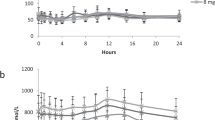Summary
To determine the elimination phenotype of the uricosuric agent benzbromarone 100 mg of the drug was administered as a single oral dose to 11 volunteers on a formula diet; plasma concentration-time profiles of the parent drug and the main metabolites M1 (1′-hydroxybenzbromarone) and M2 (6-hydroxy-benzbromarone) were measured by high-performance liquid chromatography for 168 h. Of the 11 subjects 2 showed higher plasma concentrations and delayed elimination of benzbromarone and metabolite M1 but reduced formation of metabolite M2 compared to the other 9 subjects. However, the plasma concentration-time profiles of the metabolites in these two slow eliminators, termed type 2, differed from those of a poor eliminator characterized during a previous study; the latter, termed type 1, eliminated benzbromarone as well as both metabolites M1 and M2 slowly. The differences in the elimination of benzbromarone and its metabolites are probably caused by differences in the activities of the cytochrome P450 mono-oxygenase isozymes. The results show that determination of the phenotype solely by measurement of the 24-h benzbromarone plasma concentration does not unequivocally characterize slow benzbromarone eliminators; additional plasma concentration-time profiles of the parent drug and metabolites are necessary. Metabolite M2 is characterized as 6-hydroxybenzbromarone; the formation and elimination of the chiral metabolite M1 is enantioselective.
Similar content being viewed by others
Abbreviations
- Bzbr:
-
benzbromarone
- HPLC:
-
high-performance liquid chromatography
References
Arnold, PJ, Guserle R, Luckow V, Hemmer R, Grote H (1991) Liquid chromatography-mass spectrometry in metabolic research. I. Metabolites of benzbromarone in human plasma and urine. J Chromatogr 544:267–280
Broekhuysen J, Pacco M, Sion R, Demeulenaere L, van Hee M (1972) Metabolism of benzbromarone in man. Eur J Clin Pharmacol 4:125–130
De Vries JX, Walter-Sack I, Ittensohn A (1987) Analysis of benzbromarone in human plasma and urine by high-performance liquid chromatography and gas chromatography-mass spectrometry. J Chromatogr 417:420–427
De Vries JX, Walter-Sack I, Ittensohn A, Weber E (1989) The isolation, identification and structure of a new hydroxylated metabolite of benzbromarone in man. Xenobiotica 19:1461–1470
De Vries JX, Voss A, Walter-Sack I, Rudi J, Raedsch R, Weber E (1991) New oxidative metabolites of benzbromarone. Their characterization in plasma after administration of benzbromarone to humans, and in-vitro after incubation with human and rat liver microsomes (1991). Naunyn-Schmiedebergs Arch Pharmacol 344 [Suppl 2]: R138
De Vries JX, Voß A, Walter-Sack I, Weber E, Rudi J, Spraul M, Ackermann M (1992) Structure elucidation of 6-hydroxybenzbromarone and the enantioselctive formation of 1′-hydroxybenzbromarone, main metabolites isolated from human urine. Naunyn-Schmiedebergs Arch Pharmacol 345 [Suppl 2]: R73
Eichelbaum M, Gross AS (1990) The genetic polymorphism of debrisoquine/sparteine metabolism — clinical aspects. Pharmacol Ther 46:377–394
Ferber H, Vergin H, Hitzenberger G (1981) Pharmacokinetics and biotransformation of benzbromarone in man. Eur J Clin Pharmacol 19:431–435
Gresser U (1990) Therapie von Hyperurikämie und Gicht. Mediscript, München
Gresser U, Zöllner N (1991) Pharmacokinetics of benzbromarone: evidence for a biliary-intestinal-biliary recirculation. Int J Purine Pyrimid Res 2 [Suppl1]: A55
Heel RC, Brodgen RN, Speight TM, Avery GS (1977) Benzbromarone: a review of its pharmacological properties and therapeutic use in gout and hyperuricemia. Drugs 14:349–366
Heinzel G, Woloszczak R, Thomann P (1993) TopFit version 2.0. pharmacokinetic and pharmacodynamic data analysis system for the PC. Fischer, Stuttgart Jena New York
Ittensohn A, de Vries JX (1989) A simplified method for the quantitative determination of benzbromarone in human plasma by HPLC. Eur J Clin Pharmacol 36: A228
Ittensohn A, de Vries JX, Raedsch R, Walter-Sack I, Weber E (1990) Biliary excretion of benzbromarone and metabolites in man. Falk symposium no. 57. Hepatic metabolism and disposition of endo- and xenobiotics.Freiburg/Br, 8–10 Oct. Abstracts 38
Maurer H, Wollenberg P (1990) Urinary metabolites of benzbromarone in man. Arzneimittelforschung 40:460–462
Rudi J, Ittensohn A, Voss A, de Vries JX, Raedsch R, Walter-Sack I, Weber E, Kommerell B (1991) The oxidative metabolism of benzbromarone by liver microsomes. Eur J Gastroenterol Hepatol 3[Suppl 1] 50
SAS Institute Inc. (1986) Procedures guide and SAS/STAT guide for personal computers, 6th edn. Cary, NC, USA
Vergin H, Bishop GB (1980) High-performance liquid chromatographic determination of benzbromarone and the main metabolite benzarone in serum. J Chromatogr 183:383–386
Walter-Sack I, de Vries JX, Kohlmeier M, Ittensohn A, Weber E (1987) Benzbromarone disposition and uricosuric action: evidence for hydroxylation instead of debromination to benzarone. Klin Wochenschr 66:160–166
Walter-Sack I, Eichelbaum M, de Vries JX, Weber E (1987) Benzbromarone biotransformation is not related to polymorphic oxidation of sparteine. Klin Wochenschr 66:1097–1098
Walter-Sack I, de Vries JX, Ittensohn A, Weber E (1990) Rapid and slow benzbromarone elimination phenotypes in man — benzbromarone and metabolite profiles. Eur J Clin Pharmacol 39:577–581
Walter-Sack I, Gresser U, Adjan M, Kamilli I, Ittensohn A, de Vries JX, Weber E, Zöllner N (1990) Variation of benzbromarone elimination in man — a population study. Eur J Clin Pharmacol 39:173–176
Yü TF (1976) Pharmacokinetic and clinical studies of a new uricosuric agent-benzbromarone. J Rheumatol 3:305–312
Zöllner N, Gresser U (1991) Deficient benzbromarone elimination from plasma: evidence for a new genetically determined polymorphism with an autosomal recessive inheritance. Int J Purine Pyrimid Res 2[Suppl 1] A 211
Zöllner N, Gresser U, Walter-Sack I (1990) Deficient benzbromarone elimination: a familial disorder? Klin Wochenschr 68:101
Author information
Authors and Affiliations
Additional information
Dedicated to Prof. Dr. G. Paumgartner on the occasion of his 60th birthday
Rights and permissions
About this article
Cite this article
de Vries, J.X., Walter-Sack, I., Ittensohn, A. et al. Benzbromarone hydroxylation in man: defective formation of the 6-hydroxybenzbromarone metabolite. Clin Investig 71, 947–952 (1993). https://doi.org/10.1007/BF00185609
Received:
Accepted:
Issue Date:
DOI: https://doi.org/10.1007/BF00185609




